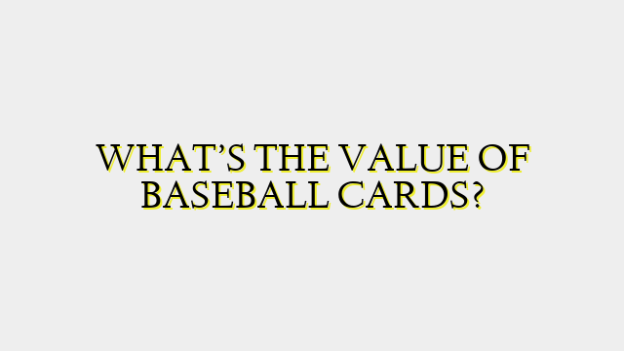The value of baseball cards can vary widely depending on several factors, so it’s important to consider the condition, year, player, and other characteristics of each individual card in your collection. Proper research takes time but is crucial for getting an accurate appraisal of what your cards may be worth.
One of the most important factors is the condition or grade of each card. The two main professional grading services are Beckett Grading Services (BGS) and Professional Sports Authenticator (PSA). They will examine factors like centering, corners, edges and surface and grade on a 1-10 scale with 1 being poor and 10 in mint condition. Generally, higher grades command significantly more value. For example, a Babe Ruth rookie card in a PSA 7 grade may be worth $50,000-100,000 but the same card in PSA 9 could fetch $250,000-500,000. So have unfavorable condition cards regraded if condition has improved over time.
The year and sport the card was produced is also highly relevant. Vintage cards from the early 20th century pre-World War 2 and iconic rookie cards tend to hold the most value. For example, honus wagner’s 1909-11 t206 tobacco card is the holy grail, with high grades selling for millions. Other examples of valuable vintage cards include the 1952 topps mickey mantle rookie ($5.2M PSA 8), 1933 goudey babe ruth (#101/$5.2M PSA 5) and 1909-11 t206 ty cobb (#110/$624,500 PSA 2.5). For modern cards, rookies from the 80s-90s boom periods are highly sought after, such as the 1989 upper deck ken griffey jr (>$10,000 PSA 10).
The player featured on the card also hugely impacts value. All-time greats like Babe Ruth, Ty Cobb, Mickey Mantle and recently retired legends tend to command top dollar. But stars of their era or players with compelling stories can also hold value – such as Derek Jeter’s debut season cards. Lesser known players may still have value in key early seasons if they have recognizable rookie cards, parallel rare inserts etc. Autographed memorabilia cards featuring game-used equipment, autographed jersey/bats/balls significantly boost value.
Beyond the individual card attributes, consider trends in the broader collectibles market. Prices typically rise when interest in a player or era is peaking. So timing a sale well based on news, anniversaries or a player’s HOF induction can maximize returns. Similarly, avoid selling at downturns when fewer collectors are actively buying. Also account for recent sale comparables, especially those achieved at major auctions which establish true market value better than individual or buy-it-now listings.
Take care to safely store and authenticity grade high value cards to protect their condition and legitimacy. Trimmed edges, rebacked/repaired surfaces, incomplete/damaged cards subtract greatly from value. Consider using acid-free sleeves and toploaders, humidity controlled storage and insurance for irreplaceable vintage gems. Professional grading also enhances resale ability by verifying authenticity and condition which buyers require for high price tags.
Properly researching each card’s attributes combined with market context and timing is needed to determine ballpark valuations. Consult multiple guides, databases and sale records of similar cards to get the most accurate appraisal possible of your collection’s true worth before selling. Taking the time for due diligence can make the difference of thousands, if not hundreds of thousands of dollars on your most prized pieces. Let me know if you have any other questions!

